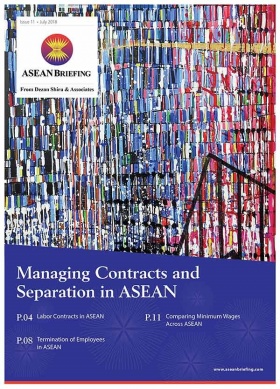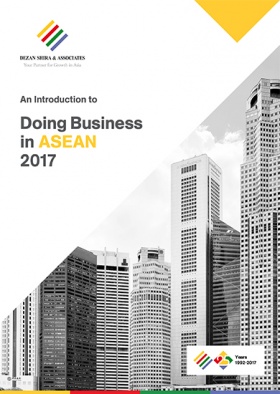Women in the Workplace in ASEAN – Part Two
In part two of this two-part series, ASEAN Briefing continues to take a closer look at women in the workplace regionally. The first part can be found here.
The employment level for women throughout the ASEAN region is important for foreign investors and international companies to understand and anticipate. Indeed, the importance of female penetration in the labor force for overall economic growth is something that could affect the prospects of multinational companies investing in any region, and is especially important in emerging economic regions such as South East Asia.
An increase in employment of women can be an indicator of how a good an economy is doing overall, as well as future prospects for available labor. Such factors can be game changers when selecting an investment location. As such, this article will profile the role of women in the labor force of three large ASEAN economies: Thailand, Indonesia and the Philippines.
Thailand
Thailand’s employment-population ratio shows that men were more likely to be employed than women. Being aware of the level of employment for females in this country has been one important indicator on the overall strength of the Thai economy.
Usually men are more employed than women, especially during a decline in the economy. However, female professionals are playing a larger role than ever before in the workplace. Participation rate of women in Thai workforce is higher than the average Asian participation rate of women.In 2012, Thai women started migrating to seek jobs as they become an increasing part of the educated work force in Thailand. Within the past decade Thai women have been present in the formal work place. According to the World Bank, in 2008 45.4 percent of women were employed in the non-agricultural sector. The private sector has been a contributor to women’s involvement in the workplace. As a result, female professionals are being touted in some corners as an important factor in an eventual pick up in the country’s growth prospects. Furthermore, Thailand’s great strides of equality in the workplace will continue.
Indonesia
Gender inequality – as in most ASEAN countries – is an issue in Indonesia. Women are twice as likely to work in the informal sector and are paid less than men for similar work. In 2009, the CIA World Fact book stated that Indonesia had a working age population of 79.5 million males and 78.9 million females.
Indonesia has significant differences in the employment-to-population ratio of men and women. The labor force participation rate of women is extremely low, with many women reporting that they are fully engaged with housekeeping responsibilities. This is a similarity that you will notice in many ASEAN countries alike. While men are more likely to work as employees, women are more likely to work as unpaid family workers. Thus, the labor force participation rate of males is higher than those of females for every age group. The average monthly income for female workers is 475,192 rupiah (US $52) and for male workers 654, 371 rupiah (US $72). Females work on average 93.18 percent of males’ hours of work, while male workers earn almost 1.38 times more than female workers.
It has been a challenge trying to boost female labor participation rate in Indonesia. However, government solutions to make this issue better have been proposed. The Indonesian government has been aiming to improve the labor participation rate of females by launching various policies and programs. Some of which include a public campaign on providing the facilities for women workers in the workplace as well as establishing Task Force on Equal Employment Opportunity and Responsive Gender program.
Philippines
The country’s female labor participation rate has been progressively increasing over the years, which is a clear sign that more women (albeit it at a very slow pace) are becoming employed in the Philippines. Results from the October 2013 Labor Force Survey showed a 0.1 percent increase in labor force participation rate for women at 49.8 percent from 49.7 percent in 2012 and a 0.2 decrease for males at 78.2 percent from 78.3 percent in 2012. The population of women government officials, corporate executives, managing proprietors and supervisors is estimated at 2.5 million, while men in the same group are estimated at 2.4 million.
Though the female labor participation rate slightly increased in 2013, men still have an overall higher labor participation rate than women. In the Philippines, women have significantly lower employment rates than men, which in 2012 gave rise to the gender gap in the employment rate. Women are also subject to the deficits of less available work, more vulnerable work and unpaid work burdens. In many occupations and industries women are paid at a lower rate than men even when they do find work.The lower Labor Force Participation Rate (LFPR) of women compared to that of men is a clear representation of the under-utilization of women’s labor in the paid labor market. This is the result of inferior employment and decent work opportunities, human capital differences and unpaid domestic labor and care constraints for women. The reasons for such gender gaps in the workforce are women have more limited access to resources, including education, training, government services, credit and financial services. Other reasons include discrimination, labor domestic work and care burdens.
Gender equitable employment and decent work are necessary for achieving both gender equality and inclusive growth in the Philippines. In order to achieve this there must be a requirement of broad macroeconomic responses to expand employment opportunities as well as making policies and legislation to improve decent work, social protection and achieve labor market support for women.
What does Improved Female Employment mean for International Companies?
Female employment has the power to enhance a company’s relations with the local community and with other business partners. This can help companies when conducting their business activities. Usha Rao-Monari, Director of International Finance Corporation (IFC) Sustainable Business Advisory stated, “Women’s participation is critical to meet the demand for skilled labor in emerging markets. Investing in women’s employment is a win-win for all, strengthening both companies and community and changing the face of the global economy”.
There have been clear patterns of the lack of female employment rate in many ASEAN countries. Some countries are worse off than others, which is also very indicative of how well the economy is doing. This is something companies should keep a careful eye on especially when thinking of starting a business in these specific countries. As a result, hiring more women can enhance a company’s workforce by making sure it is representative of its customer base and it can provide more insights into consumer preferences. Thus, understanding women’s penetration in the labor force is a key insight which decision makers must not overlook when selecting an investment destination in ASEAN.
About Us
ASEAN Briefing is published by Asia Briefing, a subsidiary of Dezan Shira & Associates. We produce material for foreign investors throughout Asia, including China, India, Indonesia, Russia, the Silk Road & Vietnam. For editorial matters please contact us here and for a complimentary subscription to our products, please click here.
Dezan Shira & Associates provide business intelligence, due diligence, legal, tax and advisory services throughout the ASEAN and Asia. We maintain offices in Singapore, as well as Hanoi & Ho Chi Minh City, and maintain Alliance offices in Bangkok, Jakarta, Kuala Lumpur and Manila as well as throughout China, South-East Asia, India and Russia. For assistance with ASEAN investments into any of the featured countries, please contact us at asean@dezshira.com or visit us at www.dezshira.com








